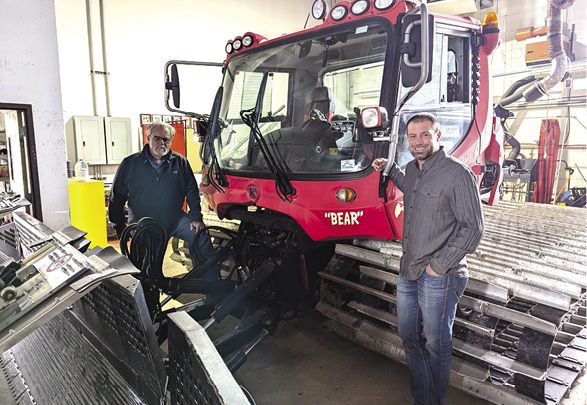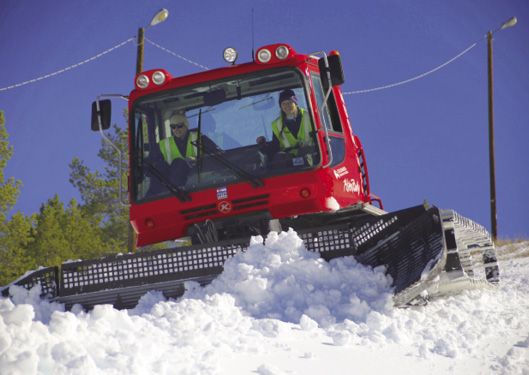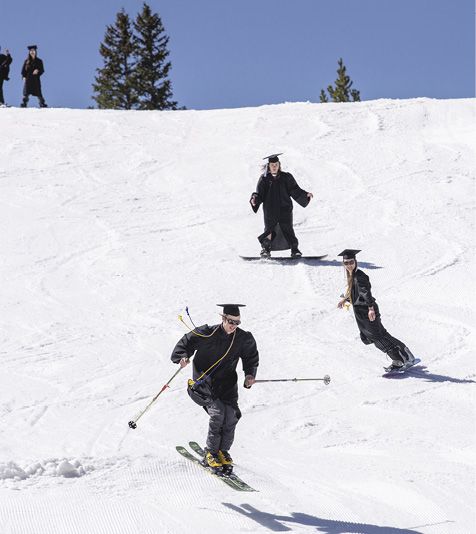Ski Business: Colorado Mountain College

Five decades of ski resort education.
Colorado Mountain College (CMC) taught its first classes in the autumn of 1967. A grassroots enterprise, the then-two-campus community college was conceived by folks in the high country as a way to keep their high-school graduates near home while pumping up the local economy. In 1965, after taxpayers in five mountain counties approved a three-mill property tax to support a junior college, ranchers near Glenwood Springs donated 588 acres for a campus; so did Lake County, which offered 133 acres near Leadville that included the Dutch Henry sledding hill and the town dump. Speaking to Donna Gray, author of the CMC history Because of You, Glenwood rancher Peter Cabrinha said, “It was a legacy to our children.”
Photo top: Assistant Professor Jason Gusaas instructs student Bruce Holmland in the field. Ed Kosmicki photo, courtesy CMC.
Six hundred students signed up for classes that first semester. Courses focused on workforce and vocational training to serve local businesses, plus continuing education for adults. There were courses in everything from accounting and animal husbandry to veterinary tech and welding. Many students wanted an affordable way to transfer to four-year colleges, so instructors were recruited for traditional academic subjects, too.
Ski Resort Boom Times
The era was the height of the expansion boom in North American skiing, especially in Colorado. Nearby Ski Cooper (10 miles from CMC Leadville), Aspen, Vail and Snowmass needed lift and trail maintenance staff; Keystone and Copper opened in 1970 and ’72, respectively. CMC’s Jim Stoner and George Steiner of the Leadville campus devised a first-in-the-country one-year certificate program for ski-area operations. They found the ideal instructor: Arapahoe Basin’s versatile veteran Alf Tieze, son-in-law of Max and Edna Dercum. The program launched in 1971. Tieze taught a variety of technical skills and put students on the hill as resort employees. For Dutch Henry Hill (named for the horse-thief-turned-prospector Henry Borne), CMC acquired a snowmaking system and snowcats for students to operate and maintain. The goal was a hands-on, learn-at-work apprenticeship program, not an academic classroom experience.

In 1974 the college launched a two-year associate degree in ski-area operations (SAO) at the Leadville campus. CMC vice president and campus dean Ben Cairns explains that today about 50 students are enrolled in the various ski-management courses and about a dozen earn the associate degree each year. Students take classes full time during the first year of the program, studying ski patrol, lift and snowmaking operations. They can earn one-year certificates in any of those specialties.
The second year provides on-the-job experience in the form of paid internships. Classes finish up before December 1 so that students can start real jobs at major ski resorts. Resort employment, full or part time, takes care of liability and health-care issues for both the students and the college. And, of course, it puts students on the ski-industry career ladder even before graduation. Sixty percent of them are from out of state—including arrivals from 13 foreign nations. According to Cairns, 95 percent of grads walk into job offers; five years later, 85 percent are still working in the ski-resort business.
Grads Move Up Quickly
“Grads get jobs quickly,” Cairns says. “They move up quickly, too, and we have about 800 graduates working all over the industry.” Alumni, he says, work technical and management jobs at Vail Resorts, Alterra and at dozens of resorts across North America, in Japan, Germany, Finland and Down Under.
Graduates include Neil Jackson, senior vice president at Resorts of the Canadian Rockies; Joe Klosterman, director of lift maintenance at Vail; Rob Ware, director of lifts at Arapahoe Basin; Geoff Marriner, director of operations at Mt. Hood Meadows (he was director of mountain ops for the 2018 Olympics in Korea); Pat Torsell, director of operations at Ski Cooper; Tony Torsell, head of business operations at Purgatory; Maddy Pierce, snowmaking foreman and cat operator at Copper and Ty Hall, owner of the Tennessee Pass Nordic Center.

Today, classes are taught by Copper Mountain veterans Jason Gutaas and Paul Molnar. Some of the graduates have returned to teach. Patroller and EMT Brian Rosser first earned a law degree, then worked as risk-management and human resources director at Loveland. He taught at CMC for some years while providing risk-management services to organizations like the National Ski Areas Association (NSAA); he now works at Idaho’s Lookout Pass. Paul Rauschke came to Colorado after studying philosophy and sociology at Illinois State University in Normal. He learned lift operations at CMC from 1984 to ’86, then, after working at Vail, came back to teach for 30 years as associate professor of ski-area operations, retiring in 2018. Klosterman of Vail is an adjunct faculty member.
The relationship with resorts, Rauschke says, is “robust.” The SAO program also provides employee training services to NSAA, Vail Resorts, Winter Park, some out-of-state resorts and the Rocky Mountain Lift Association.

Hands-on Equipment Training
Students get plenty of experience working with equipment before they get to on-hill jobs. In addition to making and grooming snow for the 200-vertical-foot tubing/sledding hill in Leadville, they can work on lift-terminal machinery and earth-moving equipment. Students running heavy equipment built 18 kilometers of Nordic trails over five years; a soccer complex in 2006; and, this year, regraded a skijoring course for Leadville’s annual competition. Students have also completed trenching and irrigation work for the town’s golf course.
For now, Dutch Henry Hill has no ski lift. Legend has it that a rope tow existed many years ago. Cairns has been working hard to bring back uphill transportation for students to build, maintain, operate and ride.
SAO students can take electives in related programs, too. Other associate degree programs include ski and snow business (retail), paramedic training, outdoor recreation leadership, hospitality management, environmental management, information technology, culinary management and general business management. One-year certificates include action-sports management; emergency medicine; avalanche science; welding; culinary and hospitality operations; ropeway electrical, mechanical and rescue operations; ski retail operations; ski patrol operations and trail maintenance.
Cultural Resource
Since 1970, CMC has grown into a cultural phenomenon. It now maintains 11 campuses across the region, with about 14,000 students. It provides vocational training to high-schoolers around the state; community cultural resources in music, art, language and dance; and has expanded to offer eight bachelor’s degree programs in nursing, business, education and environmental studies. Two-year programs transfer credits automatically into four-year degree programs at the University of Colorado.
For locals, tuition is cheap—a full-time student pays about $3,200 per year for course work (out-of-district and out-of-state students pay more). At the Leadville campus, the Mountain View Hall dormitory accommodates 110 students at rates far below what rental space would cost in town, which can be a bargain for out-of-district students. Students working full-time resort jobs often have access to employee housing, another valuable benefit.